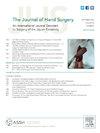掌侧钢板修复术与指间关节缝合带增强掌侧钢板修复术的生物力学比较。
IF 2.1
2区 医学
Q2 ORTHOPEDICS
引用次数: 0
摘要
目的:本研究的目的是在近端指间关节(PIP)过伸性松弛损伤模型中,对单独掌侧板修复与缝合带增强掌侧板修复进行生物力学比较。方法:从5具尸体(平均年龄59±7岁)获得10根匹配的手指。在PIP关节处分别施加5和10 N·cm的拉伸载荷,测量完整关节的松弛度。接下来,通过切开掌侧近端板并将标本加载到试验机上至30°的过伸度,建立损伤模型;重复松弛测试。在每一对配对中,一侧用于掌侧板修复,对侧用于掌侧板修复,缝合带增强。重复松弛度测量。然后将试件从2 ~ 5 N·cm加载30次,然后加载至破坏。结果:两组患者PIP关节损伤后伸角均明显增加。与损伤组相比,修复组和修复组的伸展角均明显减小。与单独掌侧板修复相比,经缝合带增强修复的标本在10、20和30次循环时的刚度显著增加(分别为3.4、3.5和3.6 N·cm/°vs 2.5、2.5和2.6 N·cm/°),屈服载荷(16.7 vs 12.4 N·cm)和极限载荷(25.9 vs 19.1 N·cm)更高,极限载荷(4.1 vs 2.6 N·cm)吸收更多能量。结论:在这项生物力学研究中,缝合带增强可增加构造刚度、屈服载荷、失效载荷和极限载荷,并可为掌侧钢板修复慢性PIP关节过伸性松弛提供额外支持。临床意义:这一发现支持使用缝合带作为加强PIP关节修复的增强物,可能导致加速恢复和更早地恢复活动。本文章由计算机程序翻译,如有差异,请以英文原文为准。
Biomechanical Comparison of Volar Plate Repair Versus Volar Plate Repair With Suture Tape Augmentation at the Finger Proximal Interphalangeal Joint
Purpose
The purpose of this study was to perform a biomechanical comparison of volar plate repair alone versus volar plate repair with suture tape augmentation in a hyperextension laxity injury model at the proximal interphalangeal (PIP) joint.
Methods
Ten matched cadaveric fingers were obtained from five cadavers (average age, 59 ± 7 years). The specimens underwent 5 and 10 N·cm of extension load at the PIP joint to measure the laxity of the intact joint. Next, an injury model was created by incising the proximal volar plate and loading the specimen on a testing machine to 30° of hyperextension; laxity testing was repeated. Within each matched pair, one side was used for volar plate repair, and the contralateral side was used for volar plate repair with suture tape augmentation. Laxity measurements were repeated. The specimens were then loaded from 2 to 5 N·cm for 30 cycles, and then loaded to failure.
Results
In both groups, extension angle significantly increased following PIP joint injury. Both repair groups significantly decreased extension angle compared with injury. Specimens that underwent volar plate repair with suture tape augmentation demonstrated significantly increased stiffness at 10, 20, and 30 cycles compared with volar plate repair alone (3.4, 3.5, and 3.6 N·cm/° vs 2.5, 2.5, and 2.6 N·cm/°, respectively), a higher yield load (16.7 vs 12.4 N·cm), and ultimate load (25.9 vs 19.1 N·cm) and absorbed more energy at ultimate load (4.1 vs 2.6 N·cm).
Conclusions
Suture tape augmentation increased construct stiffness, yield load, load to failure, and ultimate load in this biomechanical study and may offer additional support in volar plate repair for chronic PIP joint hyperextension laxity.
Clinical relevance
This finding lends support to using suture tape as an augment to produce a stronger PIP joint repair, potentially leading to an expedited recovery and earlier return to activities.
求助全文
通过发布文献求助,成功后即可免费获取论文全文。
去求助
来源期刊
CiteScore
3.20
自引率
10.50%
发文量
402
审稿时长
12 weeks
期刊介绍:
The Journal of Hand Surgery publishes original, peer-reviewed articles related to the pathophysiology, diagnosis, and treatment of diseases and conditions of the upper extremity; these include both clinical and basic science studies, along with case reports. Special features include Review Articles (including Current Concepts and The Hand Surgery Landscape), Reviews of Books and Media, and Letters to the Editor.

 求助内容:
求助内容: 应助结果提醒方式:
应助结果提醒方式:


